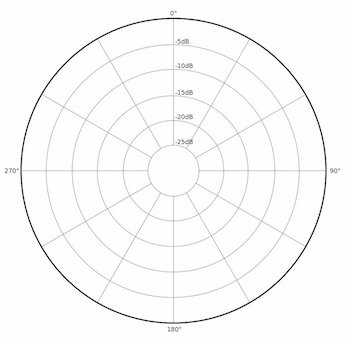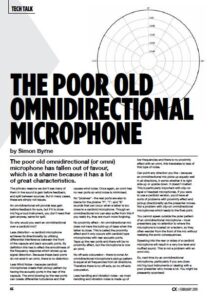Subscribe to CX E-News
TECH TALK
The Poor Old Omnidirectional Microphone
by Simon Byrne.
The poor old omnidirectional (or omni) microphone has fallen out of favour, which is a shame because it has a lot of great characteristics.
The primary reasons we don’t see many of them in live sound is gain before feedback, and spill between sources. But in many cases, these are simply not issues. An omnidirectional will provide less gain before feedback for sure, but if it is close mic’ing a loud instrument, you don’t need that gain anyway, same for spill. So why would you want an omnidirectional over a cardioid mic?
Less distortion – a cardioid microphone achieves its directionality by utilising differential interference between the front of the capsule and back acoustic ports. By definition this has to affect the smoothness of the frequency response which shows up as signal distortion. Because these back ports do not exist in an omni, there is no distortion.
Less Wind Noise – because cardioid microphones create their pickup pattern by having the acoustic ports in the rear of the capsule. The wind blowing by the rear ports can create differential turbulence and that causes wind noise. Once again, an omni has no rear ports so wind noise is minimised.
No “plosives” – the rear ports are also to blame for the plosive “P”, “T”, and “B” sounds that can occur when a talker is too close to a cardioid microphone. Though an omnidirectional mic can also suffer from this if you really try, they are much more forgiving.
No proximity effect – An omnidirectional mic does not have the build-up of bass when the talker is close. This is called the proximity effect and it only occurs with cardioid type microphones with rear acoustic ports. Tape up the rear ports and there will be no proximity effect, but the microphone is now an omni.
No off-axis colouration – there is none! An omnidirectional microphone’s pickup pattern is equal at all frequencies from all directions. Therefore there is no off-axis, so no off-axis colouration.
Less handling and vibration noise – as most handling and vibration noise is made up of low frequencies and there is no proximity effect with an omni, this translates to less of this type of noise.
Can point any direction you like – because an omnidirectional mic picks up equally well in all directions, it works whether it is right side up or upside down. It doesn’t matter! This is particularly important with clip-on lapel or headset microphones. If you were to use a cardioid version, you’d have all sorts of problems with proximity effect and pickup directionality as the presenter moves. Not a problem with clip-on omnidirectional microphones which leads to the final point.
You cannot speak outside the polar pattern of an omnidirectional microphone – most presenters pay no attention to where the microphone is located on a lectern, so they often wander from the front of the mic without realising the sonic consequences. Speaking into the rear or sides of a cardioid microphone will result in a very low level and muffled sound. This is not a problem with an omni mic.
So, next time try an omnidirectional microphone, particularly if you are close mic’ing loud instruments or dealing with a poor presenter who moves a lot. You might be pleasantly surprised!
From CX Magazine – February 2019. CX Magazine is Australia and New Zealand’s only publication dedicated to entertainment technology news and issues – available in print and online. Read all editions for free or search our archive www.cxnetwork.com.au
© CX Media
Subscribe
Published monthly since 1991, our famous AV industry magazine is free for download or pay for print. Subscribers also receive CX News, our free weekly email with the latest industry news and jobs.













